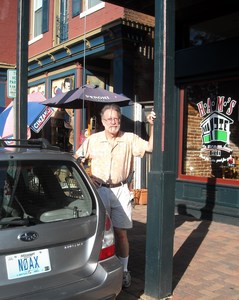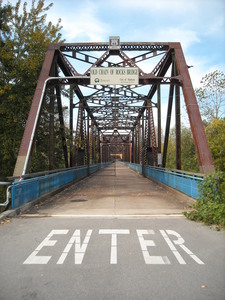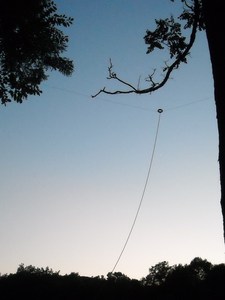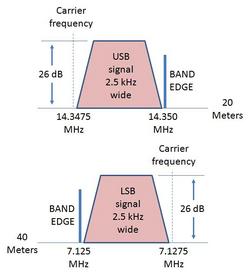 October 27, 2010 Editor: Ward Silver, NØAX | ||||||
IN THIS ISSUE
NEW HF OPERATORS - THINGS TO DO Jump right into the CQ World Wide SSB Contest this weekend and have a ball! If that wets your whistle, polish up your code capabilities for the following weekend's ARRL CW Sweepstakes. Two of the biggest and the best! BULLETINS From a 13 October press release by CQ editor W2VU: "New Multipliers in the CQWW - The country multiplier list for the CQ World Wide DX Contest (SSB weekend on October 30-31; CW on November 27-28) is based on a combination of the ARRL's DXCC list and the DARC's WAE (Worked All Europe) list. Since the ARRL has also made the same changes, deleting the old Windward and Leeward Islands entities and adding PJ2 (Curacao), PJ4 (Bonaire), PJ5/6 (St. Eustatius & Saba) and PJ7 (St. Maarten) as four new entities effective October 10, these "new ones" will each count as separate country multipliers in the CQWW. There is no need to worry if your own contest logging software is not updated, according to CQWW Contest Director Bob Cox, K3EST. "In the end, the log checking software calculates final tallies anyway," he notes, adding that the software "is very up-to-date and reflects any status changes."" BUSTED QSOS A golden issue (or at least a shiny one) last time. CONTEST SUMMARY Complete information for all contests follows the Conversation section Oct 30-31
Nov 6-7
The big news this week is, of course, the CQ World Wide SSB Contest this coming weekend. Propagation has picked up and not a moment too soon. You'll want to be ready to go, so be sure you have the very latest version of the Country (CTY) Files, updated on 25 October 2010 by Jim AD1C. Used by logging software to determine the location of a station by call sign, this latest update includes all of the recent DXCC changes and "interesting" calls that you'll hear on the bands this weekend. To install the file, follow the link to your software and then follow the instructions for checking that you have installed the file(s) correctly.
For our Spanish-speaking friends, the CQ WW rules have been translated into Spanish by the URE (Union de Radioaficionados Españoles). (Thanks, Jesus EC1KR) If you are planning to enter the CQ World Wide Contest's Xtreme category, you must pre-register your entry before the contest with your call sign and a brief description of your station. Send email to Xtreme@cqww.com. Xtreme stations are permitted to use remote transmit and receive locations, multiple operators at multiple remote locations, etc., within the rules and regulations of the country and with all transmitters within the same countryand zone. Last year's Xtreme trophy winners were B1Z (Multi-operator) and OL5Q (Single Operator). (Thanks, Doug K1DG) The third (and final) installment of the 2010 WPX Survey results are now available, discussing combining the rules for the RTTY contest with SSB/CW and general feedback and suggestions. (Thanks, CQ WPX Director, Randy K5ZD) In the Where-Are-They-Now department, Esther Schindler tracked down five of the 19 prominent programmers featured in 1986's "Programmers At Work" by Susan Lammers and got their perspective on programming and software today. For those of you that have used more than one of the original "killer apps" on the PC, this will be both nostalgic and forward-looking. Bonus - you can learn the origins of "Hungarian Notation", dig in! Having just completed the December edition of Contest Corral for QST, I thought you readers might be interested in some statistics. Of the 391 contests tracked this year, 278 (71%) are HF-only, 37 (10%) are VHF+ only, and 76 (19%) run on both HF and VHF+ bands. Mode usage shows digital coming on strong, but CW remains the most popular: Phone 192 (49%), CW 275 (70%), and Digital 149 (38%). It still remains a bit of a struggle to contact the managers of contests, though - only 69% responded to requests for information about their contest!
Web Site of the Week - I regularly receive emails from editors requesting permission to reprint one thing or another from the Contest Update. Here's how to get permission to reprint copyrighted material from any of the ARRL publications: send an email to permission@arrl.org describing what you want to reprint and your organization. You'll receive a response right away with instructions and the necessary wording. WORD TO THE WISE Rotator - the thing that turns your antenna. It's NOT a "rotor"! A rotor is an element of a device or system that rotates - for example, the rotor of an electric motor, such as the one in your ROTATOR! Is this Paul Bunyan's slingshot and does Babe the Blue Ox pull it tight? Here are two versions, one made of 2x4's and the other a more portable unit made from EMT. Caution, surgical tubing will deteriorate over time and snapping that rubber band will definitely hurt! Watch the next Mars Rover being built! This is just the thing to keep on in the shack while you're tuning the bands. Who could look at these pictures and not think "antenna radiation patterns"? Of course, there is a "do it yourself" article, too. Certificates for the 2009 ARRL September VHF QSO Party are being mailed and certificates for the 2009 ARRL November Sweepstakes were mailed last week. Winners should have been seeing them appear in their mailboxes since the weekend. 2009 Sweepstakes plaques are being processed and are the next to be shipped. You can track the development of ARRL contest awards processing online, too! Look for the "Contest Awards Processing Status" link. (Thanks, ARRL Contest Branch Manager, Sean KX9X) Results for the NA RTTY Sprint (2 weeks ago) are now posted online. The final results article will be in the Jan-Feb 2011 issue of the National Contest Journal. LCRs (Log CheckingReports) can be requested from rttysprintmgr@ncjweb.com. (Thanks, NA RTTY Sprint Manager, Ed WØYK) Doug K1DG writes to say, "Last week I shipped the last outstanding plaques for the 2007 CQ 160 Meter contests. These 28 plaques had been delayed due to health problems of the previous administrator, but are now done. With the exception of two much older plaques that were ordered as replacements, I believe that all plaques for all CQ 160M contests have been shipped. If you earned a plaque for any earlier CQ 160 Meter contest and have not received it, please contact me with the details. Plaques for the 2010 CQ 160 Meter contests will be ordered around the end of the year, after the results appear in print." OPERATING TIP
Everything you wanted to know about Sweepstakes operating is available in this great Sweepstakes Handbook from the Mad River Radio Club. You'll have to temper the propagation discussion to reflect the game in your region, but it will be great reading from end-to-end. Thanks to MRRC for making their handbook available to the contesting public. Mobile and Rover operators will be able to identify with these items in the Design News columns, "Sherlock Ohms - The Case of the Failed Battery Connections" and "The Case of the Failed Microwave Shot". It's always good to learn from the experiences of others! David K1TTT recommends an alternative to Coax Sealâ¢. "For years I have been using plain old hardware store duct seal. It comes in big 1-lb blocks for about $2...(and)...comes off much easier even after years of being on a connector. I usually just squish a big handful of it on the joint then add a layer of electrical tape outside to protect it from the sun and further push it in to the joint." If you're really concerned about removing the seal cleanly, wrap the connector with a single layer of electrical tape before applying the seal. A rolling hitch is a pretty handy knot for lifting masts or pulling on cables or ropes, but might not be a good choice if the rope vibrates because it might shake loose. Add a half hitch on the bitter end to minimize that problem. For a permanent installation, get a Kellum grip sized for your bundle of cables. They are available from 0.25" to several inches in diameter. (Thanks, Grant KZ1W) Here's a Web site for determining loading coil inductance for antennas. Placement of the coil is determined by the designer. The Web site also has links to other pages on how to design the coil. (Thanks, Jim KGØKP) A simple kit for a 3 dB power splitter is available from Clifton Labs as their product Z10050A. They cover a frequency range of 300 kHz to 100 MHz and are a handy way to split low-power signals, such as for adding a receiver. No PC board is required, just supply your own enclosure and connectors. (Thanks, Craig ACØDS) Bruce K1FZ has updated his Beverage antenna notes Web page with additional BOG (Beverage On Ground) antenna information. Here is an interesting discussion of how to balance battery loading in banks of batteries, contributed by Scott N7SS. With high loads, this could be an issue, particularly insuring that all batteries supply approximately the same current. The November issue of Nuts and Volts has a nice article on Oscilloscope Probes and Probing, active probe project by Robert Reed. You'll also find an excellent oscilloscope tutorial online there, too.
Transistors made of graphene (a single atomic layer form of carbon) will be - faster, configurable, and be able to act as an N or P type. Prototypes are switching at 100 GHz (about 10x faster than Si-based) - with possibly orders of magnitude of improvement available. Red light's frequency is about 430 THz, only 4300 times higher than 100 GHz. Remember when our radios were faster than the transistors in our computers? Not really a contest-related technology, but of interest to technically-minded radio geeks (that would be contester-related, instead) is the Department of Homeland Security's report comparing conventional and trunked mobile radio systems. In case you wanted to know about that sort of thing, of course. Technical Web Site of the Week - We have the thumb drive, why not the thumb radio? From Tree N6TR and the 17 October AMSAT bulletin comes word of the Funcube Dongle. Progress of its development and photos can be seen on the Funcube Dongle Blog. It certainly has potential for VHF+ SDR applications in rovers and portable stations. It will include (still in development) an integrated front end filter, LNA, quadrature LO, zero-IF quadrature down-converter, and a dual 16-bit ADC and USB soundcard. It's also compatible with software that works for the Softrock line of SDR components. Living On the Edge With the big CQ World Wide SSB Contest coming up and the 40 meter band allocations having evolved rapidly over the past couple of years, it's worth taking a few minutes to review some do's and don'ts, particularly for US operators. First, the lower edge of the US phone band is 7.125 MHz - not 7.100 MHz. The requirement is for you to keep your signal above 7.125 - all of it. If you are using LSB, the frequency display of your radio shows the carrier frequency and that has to be high enough that the sidebands of your signal are all inside the phone band. What does that mean? According to the FCC in Part 97.3a, everything stronger than 26 dB below the mean power of the signal counts as the signal's bandwidth.
Without getting into a huge derivation of carrier suppression and the effects on bandwidth of audio and RF compression and distortion, let's just say that you should tune no lower than 7.1275 or 7.128 MHz to be sure of "coloring inside the lines." I'm sure some enterprising contest station outside the US will set up shop with a carrier frequency of 7.125 MHz, but just don't call them. If you have a connection to the spotting network, you can always post a spot that says, "XYØZZ 7.125 Not Legal for US Phone Band" and perhaps they (and those calling) will see it and move. A similar problem over the past couple of years has been stations at the top end of 20 meters with their USB carrier frequency above 14.3475 - you're out of the band, folks! Again, just don't call them - these are not the usual frequencies for rare stations. Another "gotcha" is caused by jumping to that freshly posted spot and giving your call without looking closely at the frequency. DX stations can operate well below 7.125 MHz, 14.150 MHz, and 21.200 MHz - don't call them there! In every contest, you can hear a steady stream of US stations well outside the US band who should know better. If you can program your radios not to transmit outside the US segments or set up your spotting network filters or logging program not to tempt you with out-of-band spots, do so. That way, in the heat of battle, you won't make a mistake. Or be tempted to "make a mistake." Finally, before sending in your log - make sure it states the right category for your entry. If you receive ANY spots from the spotting networks by any means, you must enter in the Single-Operator, Assisted category (SOA). Most logging programs now automatically connect to the Internet and then to a spotting network, so you have to disable that feature if you are going to enter Single-Operator. As you get ready for radiosport's Big One, remember to play nice. Have fun, definitely, but be sure to set good examples for good operating and clean signals. The world does listen - especially when you're living on the edge! 27 October to 9 November An expanded, downloadable version of QST's Contest Corral in PDF format is available. Check the sponsor's Web site for information on operating time restrictions and other instructions. HF CONTESTS CQ World Wide SSB Contest--Phone, from Oct 30, 0000Z to Oct 31, 2359Z. Bands (MHz): 1.8-28. Exchange: RS and CQ zone. Logs due: Nov 21. Rules SKCC Straight Key Sprint--CW, from Oct 27, 0000Z to Oct 27, 0200Z. Bands (MHz): 1.8-28. Frequencies: Monthly on the fourth Wednesday local time. Exchange: RST, S/P/C, SKCC nr or power. Logs due: 2 days. Rules 10-10 Fall Digital QSO Party--Digital, from Oct 30, 0001Z to Oct 31, 2359Z. Bands (MHz): 28. Exchange: Call, name, 10-10 number, S/P/C. Logs due: Nov 15. Rules ARS Spartan Sprint--CW, from Nov 2, 0200Z to Nov 2, 0400Z. Bands (MHz): 3.5-28. Frequencies: Monthly on the first Monday evening local time. Exchange: RST, S/P/C, and power. Logs due: 2 days. Rules High Speed Club CW Contest--CW, from Nov 4, 0900Z to Nov 4, 1100Z and Nov 4, 1500Z to Nov 4, 1700Z. Bands (MHz): 3.5-28. Frequencies: Multiple operating periods. Exchange: RST and MSC member nr or "NM". Logs due: 6 weeks. Rules ARRL November Sweepstakes--CW, from Nov 6, 2100Z to Nov 8, 0300Z. Bands (MHz): 1.8-28. Exchange: Serial, category, call, check, ARRL sec. Logs due: Nov 23. Rules Collegiate ARC Championship--CW, from Nov 6, 2100Z to Nov 8, 0300Z. Bands (MHz): 1.8-28. Exchange: See ARRL Sweepstakes. Logs due: Nov 23. Rules Ukranian DX Contest--Phone,CW, from Nov 6, 1200Z to Nov 7, 1200Z. Bands (MHz): 1.8-28. Exchange: RST and serial or Ukraine oblast. Logs due: 30 days. Rules Radio Club of America QSO Party--Phone, from Nov 6, 1700Z to Nov 7, 0500Z. Bands (MHz): 3.5-21. Exchange: RST, QTH, name, equipment. Rules DARC 10-Meter Digital "Corona"--Digital, from Nov 7, 1100Z to Nov 7, 1700Z. Bands (MHz): 28. Exchange: RST and serial. Rules VHF+ CONTESTS ARRL EME Contest--Phone,CW,Digital, from Oct 30, 0000Z to Oct 31, 2359Z. Bands (MHz): 50-1296. Exchange: Both call signs, signal report. Logs due: Nov 30. Rules Fall VHF Sprints--Phone,CW,Digital, from Oct 30, 2300Z to Oct 31, 0300Z. Bands (MHz): 50. Exchange: 4-char grid square. Logs due: 4 weeks. Rules LOG DUE DATES 27 October to 9 November October 28 - 222 MHz Fall Sprint October 30 - TARA PSK Rumble Contest October 31 - New York QSO Party October 31 - German Telegraphy Contest October 31 - Washington State Salmon Run October 31 - Texas QSO Party October 31 - California QSO Party October 31 - Arizona QSO Party October 31 - All Asian DX Contest, Phone October 31 - WAB HF Phone October 31 - UBA ON Contest, CW November 1 - Feld Hell Sprint November 1 - Arkansas QSO Party November 1 - CQ Worldwide DX Contest, RTTY November 1 - F9AA Cup November 1 - Worked All Germany Contest November 1 - BARTG Sprint 75 November 3 - Araucaria VHF Contest November 6 - FOC QSO Party November 6 - 432 MHz Fall Sprint November 7 - UBA ON Contest, 2m November 8 - 10-10 Int. Fall Contest, CW November 8 - FISTS Fall Sprint November 8 - Oceania DX Contest, Phone November 8 - YLRL DX/NA YL Anniversary Contest November 9 - Scandinavian Activity Contest, SSB November 9 - Iowa QSO Party ARRL Information Click here to advertise in this newsletter. Your One-Stop Resource for Amateur Radio News and Information ARRL membership includes QST, Amateur Radio's most popular and informative journal, delivered to your mailbox each month. Subscribe to NCJ - the National Contest Journal. Published bimonthly, features articles by top contesters, letters, hints, statistics, scores, NA Sprint and QSO Parties. Subscribe to QEX - A Forum for Communications Experimenters. Published bimonthly, features technical articles, construction projects, columns and other items of interest to radio amateurs and communications professionals. Free of charge to ARRL members: Subscribe to The ARRL Letter (weekly digest of news and information), the ARES E-Letter (monthly public service and emergency communications news), Division and Section news -- and much more! ARRL offers a wide array of products to enhance your enjoyment of Amateur Radio. Visit the site often for new publications, specials and sales. Donate to the fund of your choice -- support programs not funded by member dues! ACKNOWLEDGEMENTS ARRL Contest Update wishes to acknowledge information from WA7BNM's Contest Calendar and SM3CER's Contest Calendar. | ||||||











